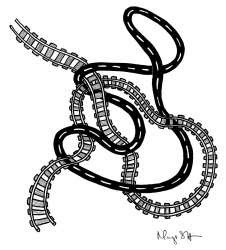 Tory Gattis, with the Center for Opportunity Urbanism, wrote an article published in the Houston Chronicle, Sunday evening. In the piece, he writes about the impact the transportation decisions made now, will have on future generations of commuters and city landscaping.
Tory Gattis, with the Center for Opportunity Urbanism, wrote an article published in the Houston Chronicle, Sunday evening. In the piece, he writes about the impact the transportation decisions made now, will have on future generations of commuters and city landscaping.
Original Text- As both H-GAC and Metro prepare new long-term transit plans, Houston is facing a critical decision point between two paths that will determine our transportation future for decades to come – and whether we continue to thrive and grow as a global city or we become another gridlocked, unaffordable LA.
The first path – sometimes called for by local officials – is the traditional approach of adding rail as cities grow beyond a certain size, with New York, Washington, D.C., Chicago and San Francisco being the largest examples. This is not only extremely expensive to build – New York is spending $2.7 billion per mile on the Second Avenue Subway – but expensive to maintain, with massive maintenance backlogs causing well-publicized chronic service problems in New York, Washington, D.C., and San Francisco.
Even worse, it turns out adding rail to sprawling Sunbelt cities built in the automobile age has been a costly failure almost everywhere, including recent bad press on Dallas DART’s high costs and low ridership, Denver’s $4.7 billion FasTracks and LA’s $9 billion rail investment leading to overall transit ridership declines. If LA – with twice our density, far worse traffic congestion and perfect walking/waiting weather – can’t make massive rail investments pay off, what chance does Houston have?
Beyond these issues, traditional transit is facing the same technological disruption as many other industries with the imminent arrival of autonomous vehicles. Shared ride services like Uber and Lyft are already causing broad transit ridership declines across the country, and estimates are that their prices could drop even further to 35 cents per mile once they go autonomous in the 2020s.
Despite the high risk of building obsolete and costly white elephants with taxpayer dollars, some cities continue to plunge obliviously into this technological buzz saw with obscenely expensive old-school rail plans like $54 billion in Seattle, $5.2 billion in Nashville, and $10-plus billion in Honolulu ($10,500 per Oahu resident!). And we’re not immune to the insanity: some of the rail plans under consideration for Houston could easily run into tens of billions of dollars.
So what’s a second path that rides this disruptive technological wave rather than drowns under it? There are hints of it in the Chronicle’s recent coverage of Metro’s commuter bus expansions and the Downtown Management District’s “Metro MAX” proposal for two-way HOV-lane bus service connecting more than a dozen major job centers. Houston is a dispersed city with many major job centers besides Downtown – like Uptown, the Texas Medical Center, Greenway, the Energy Corridor, Westchase, Memorial City, etc. – needing commuter services that would be poorly served by a downtown-centric rail network feeding less than 7 percent of the area’s jobs.
Taking it to the next level would be our proposal of an expanded network of two-way “Managed eXpress” (MaX) freeway lanes connecting every job center to every neighborhood. These lanes would be explicitly managed to move the maximum number of people at maximum speed, including converting to autonomous-only when the technology becomes available. Self-driving vehicles can run safely at much higher speeds while platooning more closely together to increase capacity. Such lanes would be more cost-effective and flexible than rail, and we estimate that this kind of network could support a million commuters to Houston’s core job centers.
But what would the experience be like for the actual commuter?
With rail, count on infrequent service because large equals more time required for getting passengers on board, frequent intermediate stops, average speeds of 25-35 mph, drop-off far from the workplace and time-consuming walks or transfers in all sorts of weather.
With MaX Lanes, there’d be comfortable public or private Park-and-Ride buses or smaller shared commuter vehicles that pick up multiple passengers going to the same job center. Custom vehicles may even have private compartments. Vehicles operate autonomously or go into auto-pilot mode as they enter the MaX Lanes, accelerating to high speeds – possibly as high as 100 mph. (Can you imagine the global publicity for Houston if we’re the first city on the planet to offer affordable 100-plus mph daily commuter services?)
These vehicles continue nonstop to major job centers then exit, where they then circulate to get commuters right to their buildings – no transfers and no risk of walking or waiting in summer heat or downpours. A faster, better experience at a far lower cost – it’s no contest.
Historically, Houston has been comfortable ignoring the conventional wisdom and going our own pragmatic way – like being the largest city in the country without zoning and building an extensive HOV/HOT bus lane network instead of costly, inflexible and slow commuter rail. We should continue that iconoclastic tradition and publicly embrace the next generation of transit instead of chasing flashy, over-priced, ineffective rail projects like other cities (and put the savings towards flood control!).
Two paths forward – one looking to the past and one looking to the future. The choice is ours.
